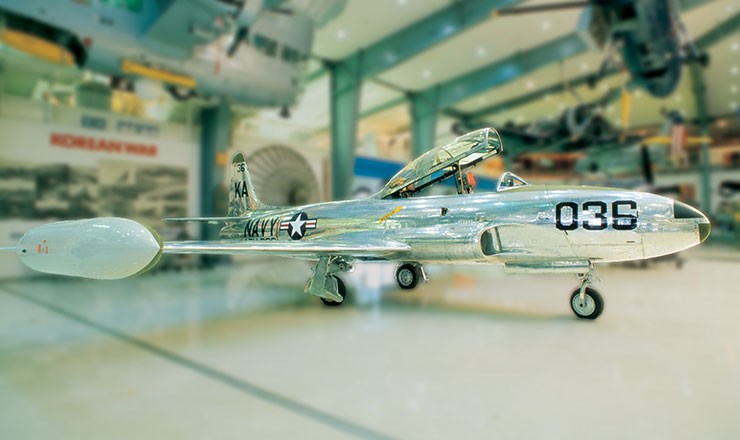TV-2 Shooting Star

Low (PNG, 319x319px, 143KB)
Med (JPEG, 1280x1280px, 55KB)
The TV-2 is a two-seat version of the P-80 Shooting Star, the U.S. Air Force's first operational jet fighter. In 1946, the Navy conducted carrier trials in the P-80 on board the carrier Franklin D. Roosevelt (CVB-42) with World War II fighter ace Major Marion Carl, USMC, flying the aircraft. The Navy procured 699 TV-2s, which trained the first generation of jet pilots and also supported missile testing as control aircraft and target drones.
Navy interest in a high-performance trainer logically accompanied the first development contracts for the Grumman F9F Panther and McDonnell F2H Banshee, two of the Navy's early jet aircraft. Delays in delivery of these aircraft prompted Navy acquisition of Lockheed's P-80 Shooting Star. Three P-80As were acquired from the Army Air Forces in 1945, with one equipped with a tailhook for trial arrested landings on board the aircraft carrier USS Franklin D. Roosevelt (CVB-42). In 1948 the Navy procured an additional fifty Shooting Stars from the Air Force as advanced trainers. First designated TO-1, their designation changed to TV-1 when Lockheed's manufacturer symbol shifted from "O" to "V" in the Navy's aircraft designation nomenclature. Though lacking tailhooks, some of these TV-1s were assigned to Fighter Squadron (VF) 52 and Marine Fighter Squadron (VMF) 311.
In 1949, the Navy initiated procurement of 26 two-seat TF-80Cs developed specifically as trainers and designated T-33. They were later redesignated TV-2s with procurement reaching 699. In 1951 several TV-2s were modified for support of missile and target trials, and designated TV-2Ds. In 1956, several more were further modified to serve as drones or control platforms, designated TV-2KDs.
Though successful as a land-based trainer, the TV-2 was not satisfactory for carrier operations. Early in 1953 Lockheed undertook to develop a carrier-capable prototype. These aircraft differed from the TV-2 in having a humped cockpit to provide better vision from the rear seat. The design sought lower landing and take-off speeds and featured a tailhook, strengthened airframe, redesigned tail and dorsal fin and modified landing gear. Lockheed replaced the TV-2's J33-A-20 engine with the J33-A-24. The Navy designated it the T2V-1 Seastar.
Built in 1958, the Museum's example of the Lockheed TV-2 is actually a U.S. Air Force T-33, originally assigned Air Force Serial Number 58-480. Acquired in 1994 and restored to the operational appearance of a Navy TV-2 with an unpainted, polished finish, it is displayed as Navy Bureau Number 131816, which served in Advanced Training Unit (ATU) 200.
SPECIFICATIONS
| Manufacturer: | Lockheed Aircraft Corporation |
| Type: | Trainer |
| Crew: | Instructor and student |
| Powerplant: | One 4,600 lb. (5,400 lb. injected) static thrust Allison J33-A-20 turbojet. |
| Dimensions: | Length: 37 ft. 8.5 in. |
| Weight: | Gross: 15,100 lb. |
| Performance: | Max Speed: 543 mph |
- Aviation
- Photograph
- Image (gif, jpg, tiff)


